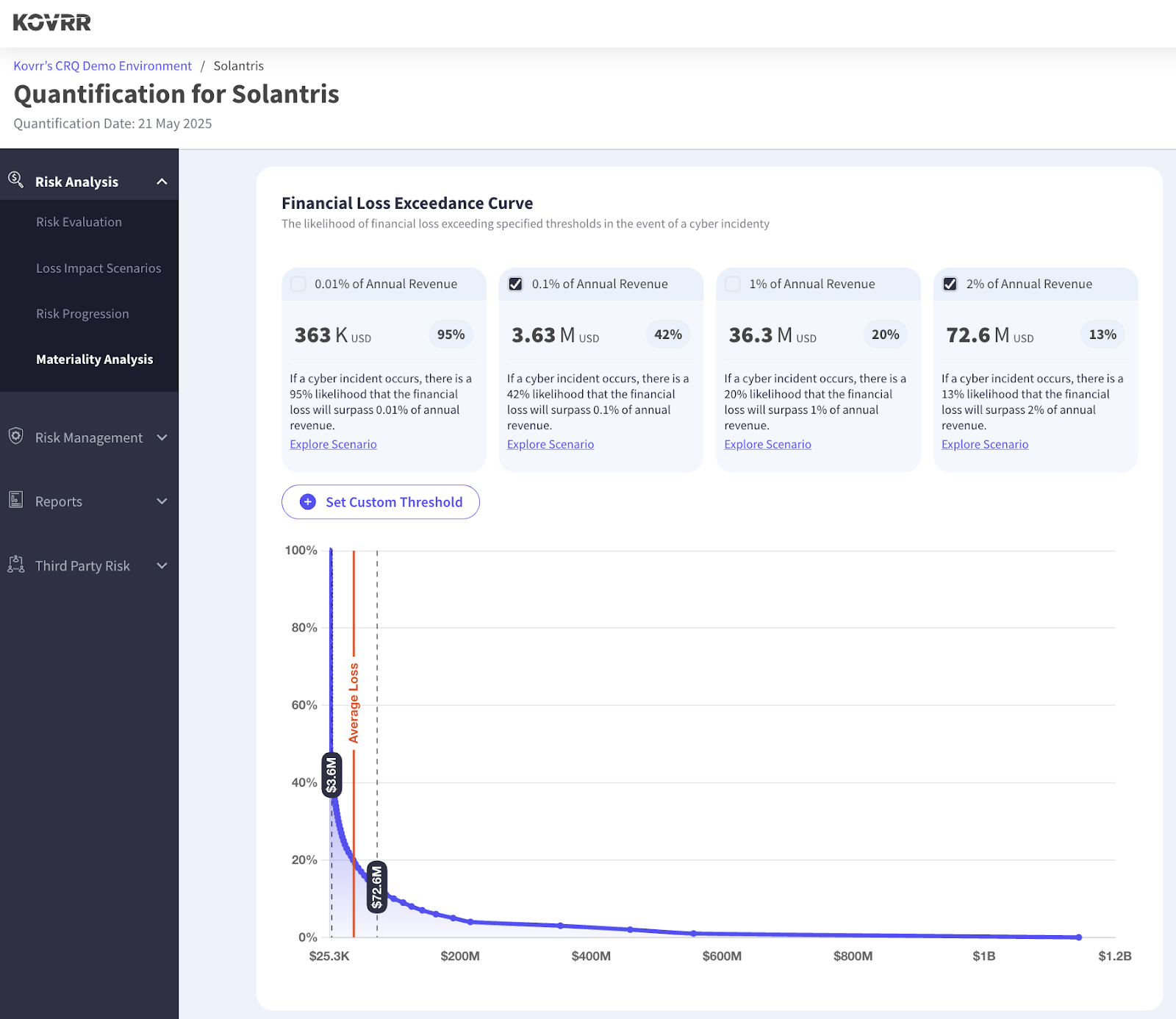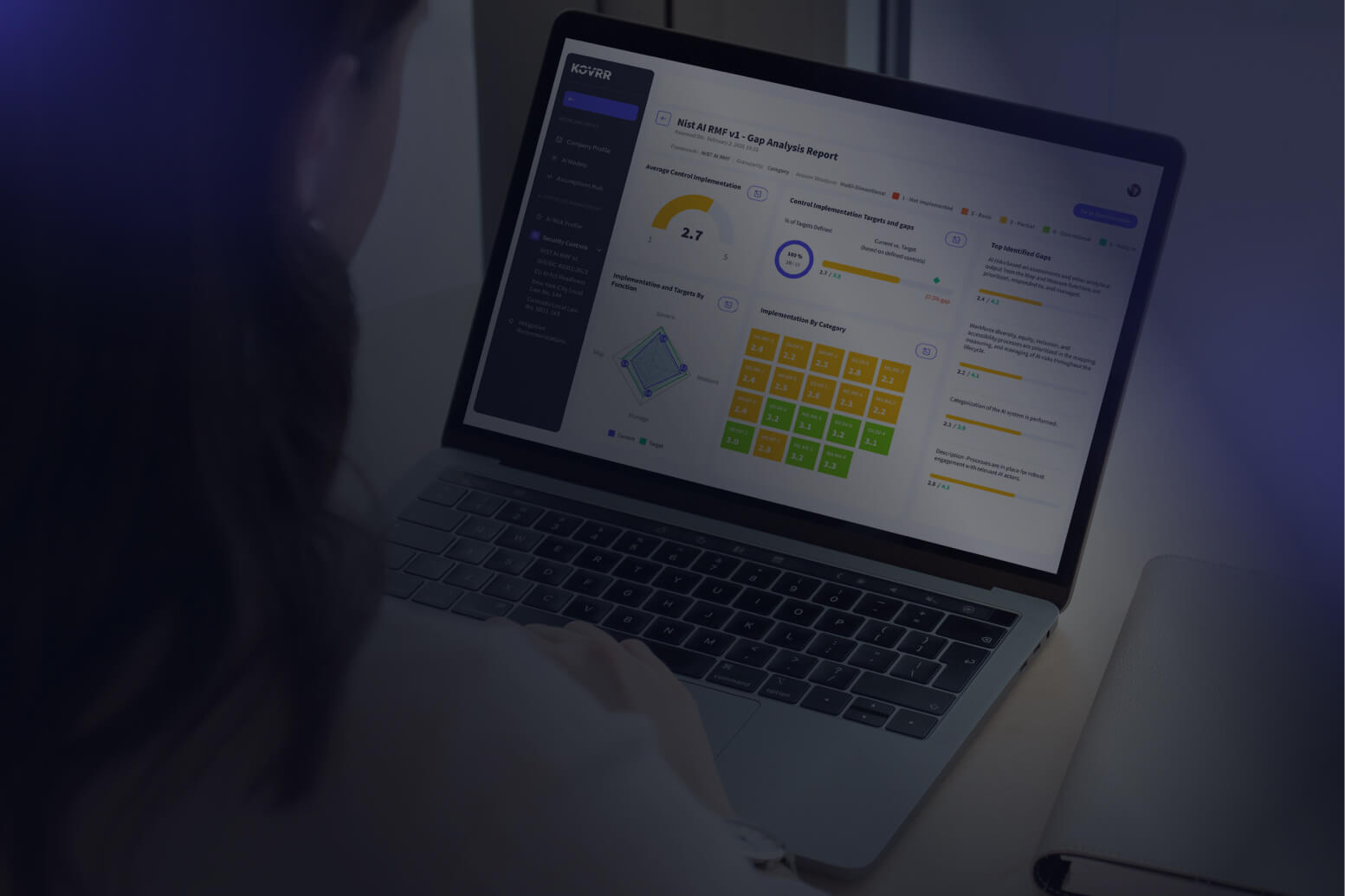Blog Post
Quantifying Cyber Risk Appetite: A Framework for Decision-Making
July 15, 2025
TL;DR
- Risk appetite expresses how much loss an organization is willing to accept while pursuing its goals. It is foundational for resource allocation and strategic trade-offs.
- Cyber risk appetite should be established by enterprise leaders, not security teams, ensuring alignment with financial strategy and broader risk-bearing capacity across all domains.
- When quantified, appetite becomes a trigger for action, clarifying when risk should be accepted, transferred, or mitigated based on objective financial thresholds.
- A pragmatic approach defines appetite using confidence levels around profitability and solvency, such as maintaining a 90% chance of annual profit or a 99% chance of solvency.
- Cyber risk quantification (CRQ) equips organizations to model loss probabilities, apply appetite thresholds in context, and guide capital deployment using data, not intuition.
Connecting Cyber Risk to Capital, Opportunity, and Resilience
Every organization pursues opportunity, which, inevitably, does not come without risk. One will accompany the other, and businesses today must manage an entire portfolio of them, including market volatility, operational disruption, regulatory exposure, reputational damage, and increasingly, financially significant cyber events.
As the volume and complexity of these costly digital risks grow, so, too, does the need for structure in how they are managed, requiring much more than identification or measurement. Risk management frameworks have, thus, become paramount, offering organizations a means by which to confidently and collectively decide how much loss they are prepared to tolerate due to these risks and how to allocate limited financial resources across competing exposures.
Cyber is, indeed, a crucial category to consider within the broader risk management system, and, like any other potentially material business risk, it must be evaluated in terms of financial resilience. In other words, with the support of tools like on-demand cyber risk quantification (CRQ), stakeholders need to determine how much loss the organization could sustain due to cyber incidents without threatening profitability, solvency, or core operations.
A quantified cyber risk appetite provides the thresholds necessary for action. For instance, if the probability of a cyber event wiping out annual profits exceeds 10%, it would likely justify a targeted mitigation initiative. Similarly, if there is a 1% likelihood that an event will occur that erodes shareholder equity, the organization may choose to transfer that risk through insurance controls. What’s more, these matters are strategic trade-offs, not isolated security issues.
Without a clear, quantitative appetite, cyber risk remains difficult to prioritize or integrate into broader resource planning, leaving it an even greater business liability. Conversely, with one, organizations can evaluate cyber exposure directly alongside other risks, enabling more deliberate and defensible decisions for building resilience.
What Is Risk Appetite?
Risk appetite refers to the level of risk an entity is willing to accept in pursuit of its objectives. On an individual level, for example, one’s appetite for risk often surfaces in choices around investing, borrowing, or other actions where uncertainty is traded for potential reward. At the enterprise level, this threshold reflects how much loss can be absorbed while still being able to meet business objectives.
According to ISO 31073:2022, the current international vocabulary standard for supporting ISO 31000, risk appetite is defined as “the amount and type of risk that an organization is willing to pursue or retain.” In practice, this encompasses both the willingness and the financial capability to bear losses, whether they are incurred from market fluctuations, operational failures, cyber incidents, or other sources of exposure.
Importantly, risk appetite is distinct from risk tolerance. Tolerance is the limit beyond which the organization cannot go without threatening its viability, while appetite represents the intended range of acceptable risk or risk boundaries within which the organization aims to operate. Appetite is a calculated management choice, while tolerance is often a constraint imposed by factors such as liquidity or solvency requirements.
Risk appetite can be defined qualitatively (e.g., “low appetite for regulatory risk”), but such descriptors are inherently vague, thereby offering limited value in guiding decisions. In the case of cyber risk, leveraging financial benchmarks and probability-based metrics provides a much clearer basis for comparing exposures across domains and for allocating capital with greater precision.
When quantified, cyber risk emerges from its traditional technical and siloed position and becomes a strategic consideration, subject to the same rigorous evaluation as other core business risks.
Who Sets the Cyber Risk Appetite?
Cyber risk appetite is a strategic threshold set by an organization’s senior leadership team, not a control-level preference dictated by the chief information security officer (CISO). It represents the level of cyber-related loss the business is willing to take on in pursuit of its goals as a proportion of its overall risk-bearing capacity. As such, responsibility for setting this threshold rests with the same senior governance bodies that determine financial strategy and enterprise-wide risk appetite.
However, while this duty resides with the board of directors, executive leadership, and enterprise risk committees, effective definition nevertheless depends on input from CISOs. These cybersecurity leaders play a vital role in translating technical risk into financial exposure, assessing control strength, and modeling potential loss scenarios. Their expertise ensures that senior decision-makers are not operating in a vacuum. Still, just as legal teams do not unilaterally define legal risk appetite, CISOs do not set cyber thresholds.
Aligning capital allocation across domains requires that cyber risk appetite be developed in conjunction with the enterprise risk strategy. It must be defined in a way that supports governance consistency, ensuring that leadership can weigh exposures across the portfolio and direct resources toward mitigating the risk areas that most threaten financial resilience.
When Does Cyber Risk Appetite Matter?
Although cyber risk appetite can surface in various contexts, its primary purpose is to inform action. When a risk scenario's average forecasted losses exceed the organization's agreed-upon appetite threshold, for instance, senior stakeholders know it is time for them to either exercise strategic restraint or have their cybersecurity teams focus efforts on minimizing this potential damage, whether through internal mitigation efforts or cyber insurance transfer.
At the same time, risk appetite levels can clarify when the more prudent approach is risk acceptance. For example, even if a proposed security initiative may offer a positive return on investment (ROI), if the risk the initiative is addressing does not exceed the organization's appetite in the first place, then stakeholders may easily conclude that resources are better spent elsewhere, such as product development.
Without this benchmark, cybersecurity decisions would be driven by individual risk tolerance or short-term pressures, resulting in inconsistent spending decisions and unscalable programs. A quantitative cyber risk appetite, however, introduces the structure and discipline required in a corporate, KPI-based environment, ensuring that cyber risk is continuously assessed through the same lens, thereby supporting coherent portfolio-level decision-making.
This consistency, likewise, supports opportunity maximization (and not just downside avoidance). Consider a scenario in which cyber risk remains within appetite boundaries, but the operational risk carries a 20% probability of exceeding quarterly profits. With this information, leadership may choose to defer cybersecurity investments and reallocate resources toward more urgent risk domains. Appetite thresholds allow organizations to weigh these trade-offs with confidence and optimize capital efficiency.
How to Quantify Cyber Risk Appetite
Quantifying a defensible cyber risk appetite begins by addressing the question of how much financial loss the organization can bear before profitability and solvency are threatened. Rather than being a static dollar figure, these monetary thresholds should be expressed in terms of annual probability. Appetite is a measurement of how likely the business is willing to accept a loss of a certain size, not only the size of the loss itself.
One particularly pragmatic and economical approach is to set the appetite in terms of confidence levels around two financial boundaries:
- Profitability threshold: A 90% probability (or better) of maintaining a positive annual net income.
- Solvency threshold: A 99% probability of avoiding losses that erode shareholder equity or exceed balance sheet capital.
Far from arbitrary, the suggested profitability and solvency thresholds reflect fundamental business constraints and definitively establish where cyber exposure must be capped to preserve organizational resilience. Moreover, they constitute a practical decision-making lens. For instance, if the probability of a loss exceeding 10% of annual profit rises above 10%, mitigation or transfer may be warranted, or if the probability of insolvency exceeds 1%, it may signal the need for more urgent intervention.
On-demand cyber risk quantification (CRQ) equips organizations to apply these broadly applicable thresholds to their specific environment, modeling the probability of financial loss based on business context. With Monte Carlo simulations, on-demand CRQ solutions generate loss exceedance curves (LECs), which illustrate the likelihood of exceeding various loss amounts over a specified period, typically one year.

Cyber risk appetite thresholds can then be represented as vertical lines on these curves, demarcating the boundaries beyond which risk is no longer acceptable. Then, cybersecurity GRC teams can compare the organization’s current exposure against these thresholds and use that perspective to guide decisions on management strategies, subsequently justifying those choices to senior stakeholders.
Teams can also leverage broader market data to help benchmark and calibrate these thresholds. In Kovrr’s Cyber Risk and Financial Resilience in the S&P 500® report, the median impact of a 1-in-10-year cyber event was roughly 1% of annual net income, with only eight companies exceeding a 10% profitability loss. At the 1-in-100-year level, the median loss was 0.7% of shareholder equity, and fewer than 10 companies experienced losses of over 10% of capital. Such market insights validate the practicality of the 90% profitability and 99% solvency thresholds, reinforcing that they are both theoretically sound and empirically grounded.
By determining cyber risk appetite through financial loss forecasts and probabilistic metrics, organizations can directly link cybersecurity strategies to outcomes that executive leadership already monitors, allowing cyber to compete more transparently for resources alongside other departments.
From Policy to Practice: Governance of Cyber Risk Appetite
For cyber risk appetite to perpetually shape how cyber decisions are made and resourced, it must be embedded within the organization’s governance policies. The first critical step in this formalization process is to mandate that cyber loss thresholds are set and sanctioned by the board of directors, the CEO, and the enterprise risk committee.
Cybersecurity leaders, particularly CISOs, should be heavily involved during respective conversations, delivering the cyber risk-related insights only they have access to. Naturally, they are expected to contextualize such threats in terms of financial, operational, or other business-related factors, helping senior executives determine whether current conditions remain within the defined boundaries. Nevertheless, the ultimate authority to establish the cyber risk appetite rests with executive leadership.
Governance should also explicitly support the continued utilization and evolution of risk appetite levels over time. Outlined in the Institute of Risk Management (IRM)’s executive guidance, functional risk appetite frameworks are useful, measurable, actionable, comparable, and responsive. In contrast to being merely documented values buried among numerous other policies, cyber risk appetite should be a core item in all risk committee discussions and capital planning processes.
Events, including but not limited to mergers and acquisitions, material market shifts, and regulatory updates, should all be catalysts for reassessing cyber risk appetite. Proactive governance keeps these thresholds in sync with dynamic business conditions. When responsibilities are clearly defined in the organization’s records, appetite starts serving as a mechanism for disciplined and transparent decision-making across planning cycles.
Cyber Risk Appetite as a Strategic Enabler
Cyber risk appetite is neither a theoretical construct nor a fluid concept. When grounded in financial thresholds and integrated into broader enterprise governance, it instead serves as a lever for decision-making, allowing organizational leaders to transform cyber risk into a strategic variable that can be weighed against profitability targets and growth constraints.
By setting clearly defined, quantitative boundaries, stakeholders establish the structure necessary to know when cyber exposure levels warrant intervention, when they can be accepted or absorbed, and how to allocate mitigation resources relative to other business risks. A formalized approach reframes cybersecurity as a domain of capital trade-offs, where investments are governed by measurable data, not subjective concerns.
When codified and leveraged consistently, cyber risk appetite equips decision-makers to seamlessly evaluate cybersecurity exposure alongside other business risks and make targeted, economically sound choices that build resilience. It transforms risk acceptance into a conscious act and ensures that cyber risk management remains aligned with enterprise performance and capital priorities.
Schedule a free demo with our team to discover how data-driven, CRQ-powered insights can help you define and operationalize your cyber risk appetite.






.jpg)
